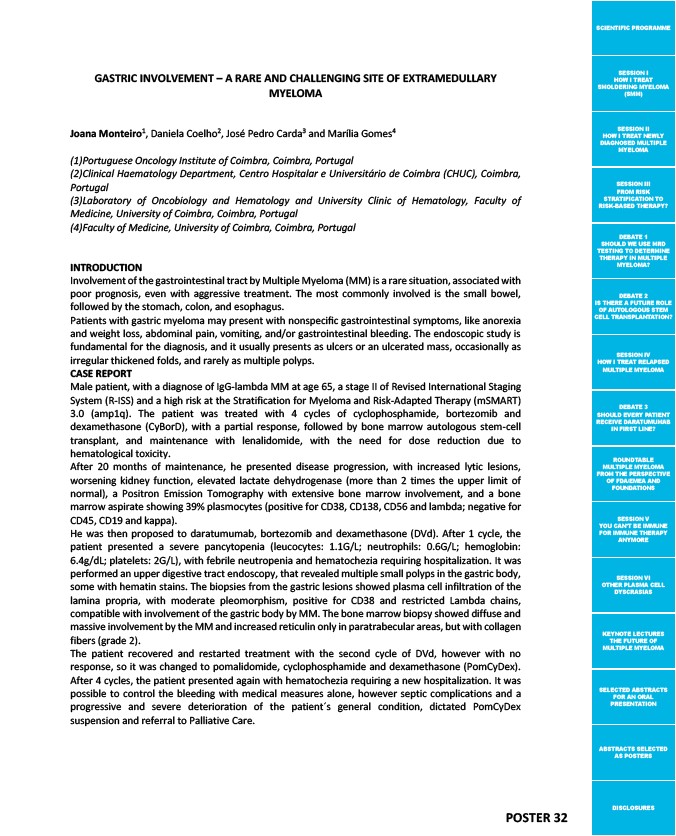
SCIENTIFIC PROGRAMME
SESSION I
HOW I TREAT
SMOLDERING MYELOMA
(SMM)
SESSION II
HOW I TREAT NEWLY
DIAGNOSED MULTIPLE
MYELOMA
SESSION III
FROM RISK
STRATIFICATION TO
RISK-BASED THERAPY?
DEBATE 1
SHOULD WE USE MRD
TESTING TO DETERMINE
THERAPY IN MULTIPLE
MYELOMA?
DEBATE 2
IS THERE A FUTURE ROLE
OF AUTOLOGOUS STEM
CELL TRANSPLANTATION?
SESSION IV
HOW I TREAT RELAPSED
MULTIPLE MYELOMA
DEBATE 3
SHOULD EVERY PATIENT
RECEIVE DARATUMUMAB
IN FIRST LINE?
ROUNDTABLE
MULTIPLE MYELOMA
FROM THE PERSPECTIVE
OF FDA/EMEA AND
FOUNDATIONS
SESSION V
YOU CAN’T BE IMMUNE
FOR IMMUNE THERAPY
ANYMORE
SESSION VI
OTHER PLASMA CELL
DYSCRASIAS
KEYNOTE LECTURES
THE FUTURE OF
MULTIPLE MYELOMA
SELECTED ABSTRACTS
FOR AN ORAL
PRESENTATION
ABSTRACTS SELECTED
AS POSTERS
DISCLOSURES POSTER 32
GASTRIC INVOLVEMENT – A RARE AND CHALLENGING SITE OF EXTRAMEDULLARY
MYELOMA
Joana Monteiro1, Daniela Coelho2, José Pedro Carda3 and Marília Gomes4
(1)Portuguese Oncology Institute of Coimbra, Coimbra, Portugal
(2)Clinical Haematology Department, Centro Hospitalar e Universitário de Coimbra (CHUC), Coimbra,
Portugal
(3)Laboratory of Oncobiology and Hematology and University Clinic of Hematology, Faculty of
Medicine, University of Coimbra, Coimbra, Portugal
(4)Faculty of Medicine, University of Coimbra, Coimbra, Portugal
INTRODUCTION
Involvement of the gastrointestinal tract by Multiple Myeloma (MM) is a rare situation, associated with
poor prognosis, even with aggressive treatment. The most commonly involved is the small bowel,
followed by the stomach, colon, and esophagus.
Patients with gastric myeloma may present with nonspecific gastrointestinal symptoms, like anorexia
and weight loss, abdominal pain, vomiting, and/or gastrointestinal bleeding. The endoscopic study is
fundamental for the diagnosis, and it usually presents as ulcers or an ulcerated mass, occasionally as
irregular thickened folds, and rarely as multiple polyps.
CASE REPORT
Male patient, with a diagnose of IgG-lambda MM at age 65, a stage II of Revised International Staging
System (R-ISS) and a high risk at the Stratification for Myeloma and Risk-Adapted Therapy (mSMART)
3.0 (amp1q). The patient was treated with 4 cycles of cyclophosphamide, bortezomib and
dexamethasone (CyBorD), with a partial response, followed by bone marrow autologous stem-cell
transplant, and maintenance with lenalidomide, with the need for dose reduction due to
hematological toxicity.
After 20 months of maintenance, he presented disease progression, with increased lytic lesions,
worsening kidney function, elevated lactate dehydrogenase (more than 2 times the upper limit of
normal), a Positron Emission Tomography with extensive bone marrow involvement, and a bone
marrow aspirate showing 39% plasmocytes (positive for CD38, CD138, CD56 and lambda; negative for
CD45, CD19 and kappa).
He was then proposed to daratumumab, bortezomib and dexamethasone (DVd). After 1 cycle, the
patient presented a severe pancytopenia (leucocytes: 1.1G/L; neutrophils: 0.6G/L; hemoglobin:
6.4g/dL; platelets: 2G/L), with febrile neutropenia and hematochezia requiring hospitalization. It was
performed an upper digestive tract endoscopy, that revealed multiple small polyps in the gastric body,
some with hematin stains. The biopsies from the gastric lesions showed plasma cell infiltration of the
lamina propria, with moderate pleomorphism, positive for CD38 and restricted Lambda chains,
compatible with involvement of the gastric body by MM. The bone marrow biopsy showed diffuse and
massive involvement by the MM and increased reticulin only in paratrabecular areas, but with collagen
fibers (grade 2).
The patient recovered and restarted treatment with the second cycle of DVd, however with no
response, so it was changed to pomalidomide, cyclophosphamide and dexamethasone (PomCyDex).
After 4 cycles, the patient presented again with hematochezia requiring a new hospitalization. It was
possible to control the bleeding with medical measures alone, however septic complications and a
progressive and severe deterioration of the patient´s general condition, dictated PomCyDex
suspension and referral to Palliative Care.